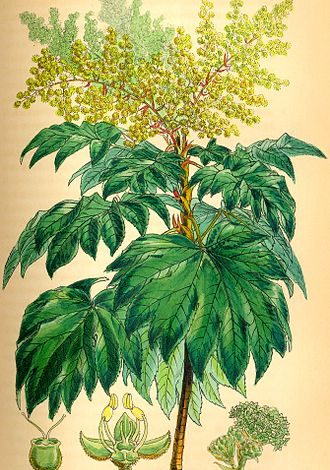
Tetrapanax papyrifer, the rice-paper plant[1] (通草—tong cao), is an evergreen shrub in the family Araliaceae, the sole species in the genus Tetrapanax.[2] The specific epithet is frequently misspelled as “papyriferum”, “papyriferus”, or “papyrifera”. It is endemic to Taiwan, but widely cultivated in East Asia and sometimes in other tropical regions as well.[3] The species was once included in the genus Fatsia as Fatsia papyrifera.[4]
A second species, Tetrapanax tibetanus, is now regarded as a synonym of Merrilliopanax alpinus.[5]
It grows to 3–7 m tall, with usually unbranched stems 2 cm diameter bearing a rosette of large leaves at the top (superficially similar to a palm crown). The leaves are carried on 40–60 cm petioles, the leaf blade orbicular, 30–50 cm across, deeply palmately lobed with 5-11 primary lobes, the central lobes larger and Y-forked near the end. It spreads extensively by sprouts from the root system underground. The inflorescence is a large panicle of hemispherical to globular umbels near the end of the stem. The flowers have 4 or 5 small white petals. The fruit is a small drupe.
Tetrapanax papyrifer is used in traditional Chinese medicine and as an ornamental. The pith from the stem is used to make a substance commonly known as rice paper,[4] but more properly termed pith paper.
